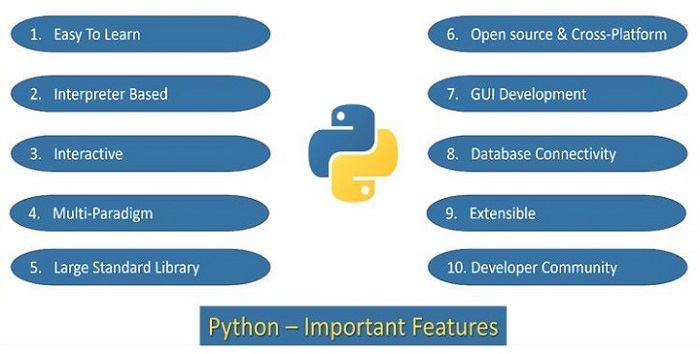Python Features
Python Features
Python is a feature-rich, high-level, interpreted, interactive, and object-oriented scripting language. This tutorial will list some of Python’s key features:
Python Features
Let’s highlight some of the key features that make Python so popular. In addition to these 10 features, there are many other interesting features that make Python the first choice for most developers.

The following sections explain these features in more detail:
Python is easy to learn and use
This is one of the most important reasons for Python’s popularity. Python has a limited set of keywords. Features include a simple syntax, the use of indentation to avoid cluttered curly braces, and dynamic typing, eliminating the need for pre-declared variables. This helps beginners quickly and easily learn Python.
Python is an interpreted language
Instructions in any programming language must be converted to machine code for the processor to execute. Programming languages can be either compiler-based or interpreter-based.
With a compiler, a machine language version of the entire source program is generated. Even a single incorrect statement will cause the conversion to fail. Therefore, the development process can be cumbersome for beginners. C-family languages (including C, C++, Java, C Sharp, and others) are all compiler-based.
Python is an interpreter-based language. The interpreter takes each instruction from the source code, converts it into machine code, and executes it. Instructions until the first error are executed are executed. This feature makes debugging easier and helps beginner programmers gain confidence. Therefore, Python is a suitable language for beginners.
Python is interactive.
The standard Python distribution comes with an interactive shell based on the REPL (Read-Evaluate-Print-Loop) principle. The shell displays a Python prompt, >>>. You can enter any valid Python expression and press Enter. The Python interpreter immediately returns the corresponding result and prompts you to enter the next expression.
>>> 2*3+1
7
>>> print ("Hello World")
Hello World
Interactive mode is particularly useful for familiarizing yourself with the library and testing its functionality. Before writing a program, you can try out small code snippets in interactive mode.
Python is a multi-paradigm language
Python is a fully object-oriented language. Everything in a Python program is an object. However, Python conveniently encapsulates its object-orientation so that it can be used as an imperative or procedural language, such as C. Python also provides some features similar to functional programming. In addition, some third-party tools have been developed to support other programming paradigms, such as aspect-oriented and logic programming.
Python’s Standard Library
Despite having only a few keywords (only 35), Python comes with a standard library consisting of many modules and packages. This provides out-of-the-box support for programming needs such as serialization, data compression, and internet data processing. Python is known for its “batteries included” approach.
Python is open source and cross-platform
Python can be downloaded from the standard distribution without any restrictions. Precompiled binaries are available for various operating systems. Furthermore, the source code is also freely available, which is one reason it is classified as open source.
Python software (including documentation) is released under the Python Software Foundation License, a permissive BSD-style software license compatible with the GNU General Public License (GPL).
Python is a cross-platform language. Precompiled binaries are available for various operating system platforms, including Windows, Linux, Mac OS, and Android. The reference implementation of Python is called CPython and is written in C. You can download the source code and compile it for your operating system platform.
Python programs are first compiled into an intermediate platform-independent bytecode. A virtual machine inside the interpreter then executes the bytecode. This behavior makes Python a cross-platform language, so Python programs can be easily ported from one operating system platform to another.
Python for GUI Applications
The standard distribution includes an excellent graphics library called TKinter. It is a Python version of the popular GUI toolkit TCL/Tk. You can use Python to build attractive and user-friendly GUI applications. GUI toolkits are typically written in C/C++, and many of them have been ported to Python. Examples include PyQt, WxWidgets, and PySimpleGUI.
Database Connectivity with Python
Almost any database can be used as a backend for Python applications. The DB-API is a set of specifications for database driver software that allows Python to communicate with relational databases. Using a variety of third-party libraries, Python can also be used with NoSQL databases such as MongoDB.
Python is extensible
The term “extensibility” implies the ability to add new functionality or modify existing functionality. As mentioned earlier, CPython (the reference implementation of Python) is written in C. Therefore, modules/libraries can be easily written in C and incorporated into the standard library. There are other Python implementations, such as Jython (written in Java) and IPython (written in C#). Therefore, new features can be written and merged into these implementations, using Java and C#, respectively.
Python’s Active Developer Community
Due to Python’s popularity and open source nature, many Python developers often interact in online forums and conferences. The Python Software Foundation also has a large member base dedicated to promoting, protecting, and fostering the development of the Python programming language.
Python also has significant institutional support. Major IT companies such as Google, Microsoft, and Meta have made significant contributions by preparing documentation and other resources.